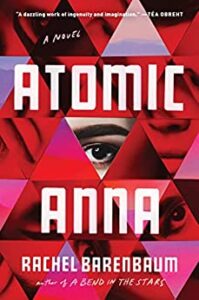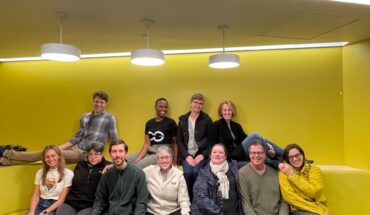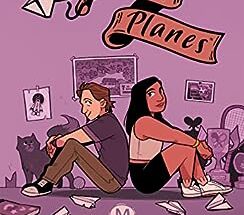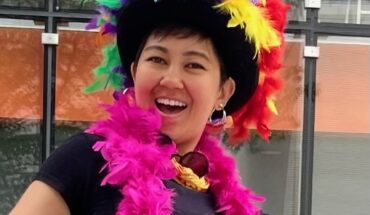 In Rachel Barenbaum’s sweeping time-travel novel, ATOMIC ANNA, three generations of women must work across time and continents to change their lives and the history of the world. This is a gorgeous story of family, science, love, and an abiding faith in something better. I spoke with Barenbaum recently about what it means to be writing about Russia in the current moment of the war on Ukraine, why science animates all of her books, whether time travel with ever actually happen, and about her fan-girl moment with MAGIC TREEHOUSE author Mary Pope Osbourne.
In Rachel Barenbaum’s sweeping time-travel novel, ATOMIC ANNA, three generations of women must work across time and continents to change their lives and the history of the world. This is a gorgeous story of family, science, love, and an abiding faith in something better. I spoke with Barenbaum recently about what it means to be writing about Russia in the current moment of the war on Ukraine, why science animates all of her books, whether time travel with ever actually happen, and about her fan-girl moment with MAGIC TREEHOUSE author Mary Pope Osbourne.
In re-reading ATOMIC ANNA in the time of the Russian war on Ukraine, I found myself thinking about Anna believing she was doing the right thing, just as many Russians believe their country is doing the right thing. I couldn’t help but think that the more things change, the more they stay the same. What do you hope readers in this current moment will take away from that character of Russia that appears in your book?
Anna grew up as a Soviet, at the edge of the Russian Revolution and was pulled into the Soviet Union. But she always believed it had never changed: it was all the same scientists and all the same people. What I really want readers to come away with is thinking about this big moral question of just because we can, doesn’t mean we should. Just because I can build this horrible weapon, just because I can use it to change the course of history, build something that could end all wars, doesn’t mean that I have the right to do that. She struggles with that with a couple of other characters and I talk about how they talk about you could create a panel, a group of people who could come together and do that. Ultimately, my characters realize that it’s not up to us to decide what we can do and so, what I really hope people start to think about is this idea that all science should begin with ethics. Just because we can build some massive satellite that can peer out into the galaxies, does that mean we should actually build it? Because the government that supported it can turn that satellite around and use it to look down on us for surveillance. If only all science could only start with the ethical question of “Do we actually want this at the end of the day?”
Tell me about your relationships to Russia—why is this a well you keep dipping into?
My grandparents came from Russia. When they got to America, they continued to speak Russian and Yiddish amongst themselves. But then I came along and my cousins and brother and sister, we were not to speak any Russian or Yiddish. We were only allowed to speak English and French. Because French meant you had arrived—it was the language of Russian nobility. I have always wanted to know about Russia and the Soviet Union and was always forbidden to talk about it, to go there. Of course, anything you are forbidden to do, you totally want to do to. And I am still obsessed with this language that I’ve never learned and this country that I’ve never visited, because it is forbidden in my family.
I’ve been lucky enough as a writing partner and classmate of yours to have read this book in so many different iterations. I have said this to you many times, but I so admire your flexibility in its construction—much like Anna’s timelines moving around, or not happening at all, you have moved pieces or gotten rid of them completely. Can you say more about your process of writing and editing? It feels as if nothing is precious.
I don’t think of any of my writing as precious; I don’t. If a scene isn’t working, if a character isn’t working, I’m very happy to cut it. I would rather cut it sooner rather than later. And I save the pieces, and think, “Maybe one day….” One of the very early scenes in this book you read, there is this ship that rises up—
The ship! Yes. I think about that ship once a month! I love that scene. Did you try to put it back into this book?
I tried to put it into a new scene, but no. Once it was gone, it was gone. My editor was like, “No. It just doesn’t fit.” I thought it was beautiful writing and a really cool scene and was into it. But it had to go. It just didn’t have a place in the book. But I’m hoping I will find a place for it one day.
Describe your writing day for us.
I do my writing time in the morning from 8-11:30 or 12:00. And then in the afternoon, I tend to do more reading and researching. I am still writing some stuff, it’s just usually not as good writing for me as before, but I hang on until 4 or so.
Right now, I am spending so much time on social media. I am so appreciative of all the people who are reading my book and posting about it, and I want to thank each of them, and it takes a long time to do that.
I am giving myself four weeks of social media, so I am not producing new content right now. Well, that’s not true. I have a whole bunch of new essays coming out. Part of the process leading up to the publication is what Courtney Maum (author of BEFORE AND AFTER THE BOOK DEAL) calls “The Personal Essay Tour of Duty.” I am on that right now. I have 7 essays coming out.
I wrote a piece on the anniversary of the sports bra and Title IX. Harper’s Bazaar is publishing that in June. Another thing I love to do: I interviewed Jennifer Egan about her new book, CANDY HOUSE, for LA Review of Books. We share the same pub day and I love her book. She is so smart and so kind.
You know how much I love the science and math in this book—it warms my nerdy heart. Lines like this abound: “If Soviets had any religion at all, it was math. Like Raisa, they seemed to understand that numbers and algorithms were skeletons that held the skin of the universe together. They defined space, orbits, the dimensions of the room, the length of the day, the weight of the marrow bones in Raisa’s bowl.” How did you become interested in those subjects?
I love science because science starts in philosophy, and these questions of “Why do we exist?” It’s another way of defining the room. I don’t necessarily love working with the equations to define the room or the marrow bones in my bowl, but I love the questions it’s tackling and that it’s looking for answers. I don’t want anybody, including my readers, to be afraid of math and science because it is part of everything—everything we do is touched by math and science, including this interview that we are doing right now, which would not be possible without our computers and the math and the science that created them. I really like to pull that in, and show strong women and girls in math and science. I want my daughter to read about strong women and girls in science because that’s how we make strong women and girls in science, when they see them.
What’s your first kernel of an idea for your books—is it wanting to show strong women and girls in science? Is it character-based? Is it setting-based?
For this one, in 2016, I was looking at these photo essays coming out of Chernobyl thirty years later. It looked like a ghost town. There is one in particular of a pool that made me think about how it was such a ghost town there, and made me think, “I want to write about this somehow.” And then I saw this National Geographic expose on this cosmic ray station that the Soviets built on Mt. Aragats and I thought, “That is crazy! That’s real. That exists.” And there is just one guy who lives up there, tending to the equipment, because he’s afraid to leave. I can only write about women, so I was trying to figure out how to put women into these places—into Chernobyl, into Mr. Aragats—and that’s how I came up with this story.
What made you want to write a time travel novel?
I’ve always loved time travel books and movies. Since reading HG Wells’ THE TIME MACHINE, I’ve always loved it, everything about it. When you think about the Chernobyl disaster, it’s freaky. You look at the pictures and everything that happened, and how it distorts nature and animals and people, and I just thought something had to have happened within that explosion that took place. I don’t know how I came to time travel, but I just knew that something big must have happened when it melted down.
Any others in this genre that you particularly love?
All of them! From Audrey Niffenegger’s THE TIME TRAVELER’S WIFE, Stephen King’s 11/22/63. I love the play that I talk about in the book that’s about time travel—Ivan Vasilievich. Back to the Future, of course, Terminator. I just love all of them. They are just so good. Think about the MAGIC TREEHOUSE series!
That’s all we read in our house right now.
I just love it all. I met Mary Pope Osbourne once and just said, “YOU ARE AMAZING!” I said, “I can’t even say anything to you because you’re so cool.” She said, “Breathe.” And all I could say was, “Books. So. Good. So. Good.”
We should all be so lucky to have fan girl moments like that.
Exactly! Although she is probably used to that with little kids, not this grown woman.
They are so good though. And I was reading one after re-reading your book, and thinking about how they always come back to the exact time that they left. It made me think about all the strictures and rules that have to happen with time travel books.
Any time travel story has to have strict rules or they don’t work. Readers or viewers are like hawks watching it if the author messes up or the director—everyone knows. The big one that I struggled with in my drafts was that I knew I wanted Anna to be dying from time travel. Because Chernobyl was deadly, but I killed her too quickly in one draft. My editor thought she seemed like she was an old woman who didn’t even know what was happening. She said, “You can’t hate her, you can only pity her.” She said I needed to reel that in so she wasn’t getting that sick, that quickly.
Wait, are we supposed to hate her?
Oh, I like that. So you like Anna?
I wouldn’t say I like her, but I didn’t ever hate her.
She’s not supposed to be a soft, funny, lovable character. She’s like my very harsh grandmother in the sense that you love her, you know underneath that she’s soft and warm, but she’s not going to be fuzzy and hugging anyone.
Maybe I understood her a little? And this leads into my next question, I was struck in the book how often the mothers struggled with something we’ve talked a lot about: namely how do you balance motherhood with work or other passions? How did you approach that in this book?
I really wanted Anna to show that push and pull between “I really want to work” and there should be nothing wrong with that. There are men who do that and they end up marrying and the wife will take care of everything. Why can’t Anna be the one who wants to work? She wants her husband to take care of everything. He doesn’t and everything falls apart, but I really wanted her to be devoted to her work in the ways that you often see men are devoted. And the reaction to that has been mixed. People don’t like her for that, because sometimes people want to see women who are more maternal. She actually says, “I want to work. And in fact, I’m willing to give up my child and my family so I can keep working. I want to work so badly.” And lots of men do that all the time! We just don’t talk about that.
I loved the ending of your novel, the way it ended on an uplifting but still very real note. Time travel allowed people to change, but not completely—without giving too much away, can you say a little about the ending? Had it changed over time? What do you want readers to take away from it?
The next to last scene where we see Xenia in the Revolution, that scene was the very first scene that I wrote for this book. That hasn’t changed…but then I thought how does that end? I love happily-ever-afters, and I know not everyone does, some people want to see unsolved things, but I wanted that in there. But, I wanted to stay true to the characters—fine, they went back and changed things, but not everything changes.
Tell me about the comic books that appear in this book. Did you read comic books as a kid?
I did read comic books as a kid, not as intensely as Molly, but I love art. And I wanted to show that there is more than one way to see in the world, it isn’t just math or science, but you could be a brilliant artist. But also, that you can fall down. And that’s Molly. I also wanted to bring them in because comic books are a real feminist lighting rod in that in traditional comic books, women were always thrown into refrigerators and fighting over men and being jealous. I don’t know why, but they are thrown into refrigerators all the time. Trina Robbins was the leader of this women’s comics movement, who was in my book, who led this whole movement showing strong women who aren’t being thrown into refrigerators and aren’t fighting over men. As I finished the book, the comics and the three main characters were still with me: Atomic Anna, Mighty Minerva, Rocket Raisa. I love new artists as much as I love new authors, so I found this database called Visible Women run by Kelly Sue Deconnick, that works to get women artists hired. I went through it, picked out a few that I thought would be a good fit, and I emailed them and said, “What do you think about drawing a few pictures of these women that I imagine?” These two young, hungry, and brilliant, brilliant, brilliant artists—Angela Wu and Emily Ree—have drawn some of these characters.
Okay, last question: do you think time travel will ever actually happen?
Yes. I believe it will.
Rachel Barenbaum’s debut novel, A BEND IN THE STARS, was a New York Times Summer Reading Selection and a Barnes & Noble Discover Great New Writers selection, and a Boston Globe bestseller. She has written for The LA Review of Books, LitHub and Dead Darlings. She is a graduate of Grub Street’s Novel Incubator and the founder of Debut Spotlight at A Mighty Blaze. For more info go to rachelbarenbaum.com, or follow her on Instagram or Twitter.



